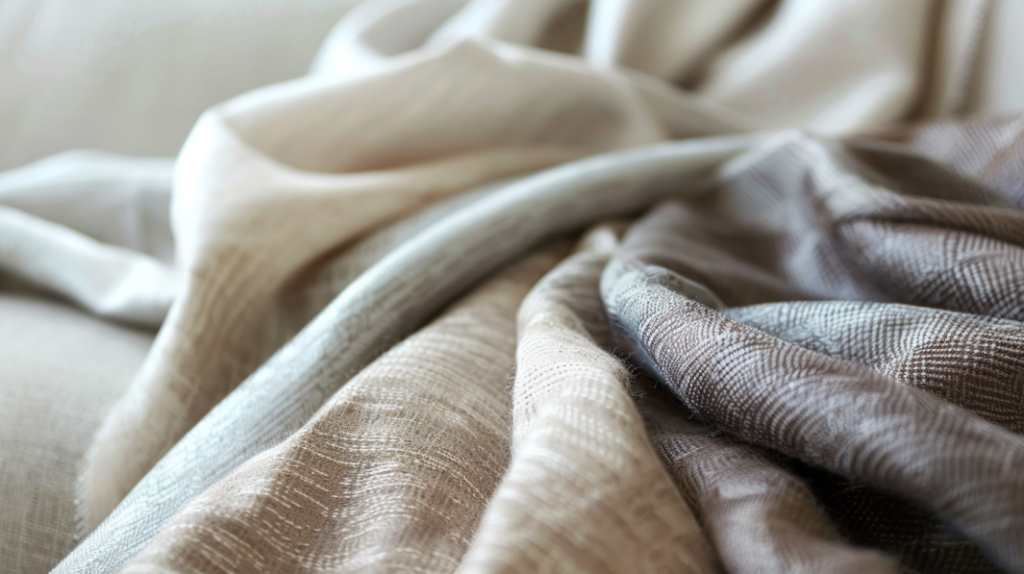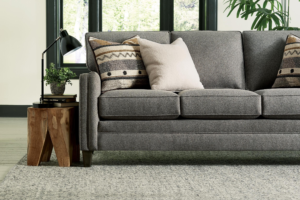Choosing the right fabric for your home decor is an important step in creating a cohesive and inviting space. Fabric choices significantly influence the look, feel, and functionality of a room. From upholstery and curtains to pillows and rugs, the fabric you select impacts both the aesthetics and durability of your home decor. To make the best choice, you need to consider various factors such as style, durability, color, texture, and maintenance.
In this guide, we’ll break down the key considerations for selecting fabric for your home decor and provide tips on how to choose the perfect material for each purpose.
Key Factors to Consider When Choosing Fabric for Home Decor

1. Purpose and Function
Before selecting fabric, think about the purpose it will serve in your decor. Is it for upholstery, curtains, throw pillows, or bedding? Each type of fabric is better suited for certain functions based on its durability, comfort, and look.
- Upholstery fabric: Durability is a top concern for upholstery since sofas, chairs, and ottomans endure heavy use. Performance fabrics, leather, and microfiber are ideal for high-traffic areas, while delicate fabrics like silk or linen may be better for decorative furniture that isn’t used daily.
- Curtains and drapes: For window treatments, choose fabrics that are light, airy, or heavier depending on the light control and privacy you need. Sheers like voile or cotton offer a breezy look, while velvet or heavy linen provides better insulation and a more formal appearance.
- Pillows and throws: For decorative accents like pillows and throws, you can opt for more luxurious or trendy fabrics like velvet, faux fur, or silk since they’re easier to replace and don’t face the same wear and tear as upholstery.
- Bedding: Comfort is the main factor for bedding. Natural fabrics like cotton, linen, and bamboo are breathable and ideal for creating a comfortable, cozy bedroom environment.
2. Durability
Durability is key when choosing fabric for high-use items such as sofas, chairs, or rugs. Consider how much use the item will get and select a fabric with the right durability level.
- Heavy-duty fabrics: For furniture in high-traffic areas or homes with pets and kids, opt for durable fabrics like performance textiles, microfiber, or tightly woven cotton blends. These materials resist wear and tear, pilling, and fading.
- Delicate fabrics: For accent furniture or decorative elements, you can choose more delicate fabrics like silk, velvet, or linen, but keep in mind these may require more care and maintenance.
- Fabric rub count: To measure durability, consider the fabric’s rub count (or double rubs). A higher rub count indicates a more durable fabric. Fabrics with 15,000–20,000 rubs are suitable for everyday use, while 30,000+ rubs are ideal for heavy use.
3. Style and Aesthetic
Fabric plays a major role in setting the tone and style of a room. The material’s color, pattern, and texture should match your overall decor style, whether it’s modern, traditional, eclectic, or rustic.
- Modern decor: Opt for sleek fabrics like leather, linen, or microfiber in solid colors or simple geometric patterns. Minimalist designs benefit from clean lines and neutral tones.
- Traditional decor: Rich textures such as velvet, brocade, and jacquard with classic patterns like florals, paisleys, or damask enhance traditional interiors. Deep, warm hues or elegant jewel tones create a more formal, sophisticated look.
- Rustic or farmhouse: Natural materials like cotton, burlap, and linen in muted colors or earth tones fit well in rustic settings. Fabrics with a rougher, textured appearance, such as wool or tweed, also add warmth and charm to rustic decor.
- Bohemian or eclectic: For a more relaxed, eclectic look, opt for bold patterns like tribal prints, paisley, or tie-dye. Mixing and layering textures such as suede, faux fur, and patterned cottons can create a vibrant, dynamic look.
4. Color and Pattern
The color and pattern of the fabric have a profound effect on the room’s ambiance. Choosing the right hue and design ensures the fabric enhances the room’s overall decor rather than competing with it.
- Light vs. dark colors: Darker fabrics hide stains better and add a sense of coziness to a room, while lighter colors make the space feel larger and more open. Consider the room’s natural light when choosing fabric colors.
- Neutral tones: Neutrals like beige, gray, and white offer versatility and can be paired with various other colors or patterns. They provide a timeless look and are perfect for foundational pieces like sofas and curtains.
- Bold colors: Bright colors like teal, mustard, or emerald can be used to make a statement or create a focal point in the room. Consider adding bold fabrics in accent pieces like pillows or throw blankets.
- Patterns: Large patterns can make a room feel more dynamic, while small patterns are more subtle and versatile. Floral patterns, stripes, plaids, or geometric designs can each bring different moods to your space. Large-scale patterns work well in bigger rooms, while small prints fit better in compact spaces.
5. Texture
Texture plays a crucial role in adding depth and interest to your decor. The feel of the fabric can enhance the room’s overall atmosphere, whether you’re aiming for cozy, formal, or relaxed.
- Smooth textures: Fabrics like silk, satin, or microfiber have smooth, sleek surfaces that add a polished, formal look to a room. They are great for modern, minimalist, or sophisticated interiors.
- Textured fabrics: Rougher textures like tweed, wool, or linen create a more casual, cozy, and inviting feel. These fabrics add warmth and are perfect for rustic, bohemian, or laid-back living spaces.
- Layering textures: Mixing different textures can elevate a room’s design. Pairing a smooth leather sofa with plush velvet pillows or a wool throw can create visual and tactile contrast, adding richness to the decor.
6. Maintenance and Cleaning
Maintenance is an important consideration, especially in high-traffic areas or homes with children or pets. The fabric you choose should match your lifestyle and the level of care you’re willing to provide.
- Easy-to-clean fabrics: Performance fabrics, microfiber, and certain types of synthetic fabrics are stain-resistant and easy to clean, making them ideal for families with kids or pets. Many of these fabrics can be spot-cleaned or machine-washed.
- Natural fibers: Fabrics like cotton and linen are breathable and comfortable, but they can be prone to wrinkling and staining. Pre-treated stain-resistant cotton or linen options are available, but these materials may still require professional cleaning over time.
- Leather: Leather is easy to wipe clean and maintains its appearance with regular conditioning. However, it can be susceptible to scratches and requires more upkeep than synthetic alternatives.
- Velvet and silk: These luxurious fabrics are more delicate and may require professional cleaning. Avoid placing velvet or silk furniture in high-traffic areas, as they are prone to staining and wear.
7. Environmental and Ethical Considerations
For eco-conscious decorators, the sustainability and ethical sourcing of fabric are key factors. Consider choosing fabrics that are environmentally friendly and responsibly produced.
- Natural fibers: Organic cotton, hemp, bamboo, and wool are renewable, biodegradable, and eco-friendly options that reduce the environmental impact compared to synthetic fabrics.
- Recycled materials: Many modern fabrics are made from recycled materials, such as recycled polyester, which reduces waste and helps support sustainable practices.
- Low-impact dyes: Look for fabrics that use eco-friendly dyes or are certified by organizations like OEKO-TEX or GOTS (Global Organic Textile Standard) to ensure the fabric meets environmental and safety standards.
Choosing the Right Fabric for Different Home Decor Elements
1. Upholstery
For sofas, chairs, ottomans, and other large furniture pieces, durability and comfort are key. Look for heavy-duty fabrics such as performance textiles, leather, microfiber, or tightly woven cotton blends for long-lasting use. Select colors and textures that complement your home’s aesthetic, but also keep practicality in mind for cleaning and upkeep.
2. Curtains and Drapes
Curtain fabric should balance aesthetic appeal with functionality. Light, breezy fabrics like cotton, linen, or sheer voile are ideal for allowing natural light to filter through while adding softness to the room. For a more formal or dramatic look, heavier materials like velvet or damask offer a rich, luxurious feel.
3. Pillows and Throws
Pillows and throws provide an excellent opportunity to experiment with textures, patterns, and colors. These are easily replaceable and can be updated with the seasons or when trends change. Opt for cozy materials like faux fur, knit fabrics, or velvet to add warmth, or go for vibrant prints to liven up a neutral room.
4. Bedding
When choosing fabric for bedding, comfort is the top priority. Natural, breathable fabrics like cotton, linen, or bamboo help regulate temperature and create a soft, inviting environment. If you’re looking for luxurious bedding, opt for high-thread-count cotton or silk.
Conclusion: How to Choose Fabric for Your Home Decor
Choosing the right fabric for your home decor involves considering durability, style, comfort, color, pattern, and maintenance. Whether you’re upholstering furniture, dressing windows, or selecting accents like pillows and throws, the fabric you choose will affect both the visual appeal and functionality of your space. By balancing these factors with your lifestyle and design preferences, you can create a beautifully cohesive and comfortable home decor scheme that stands the test of time.











